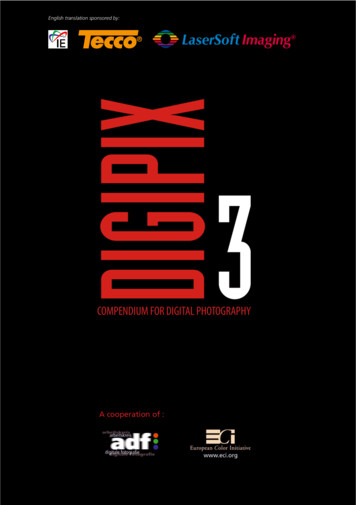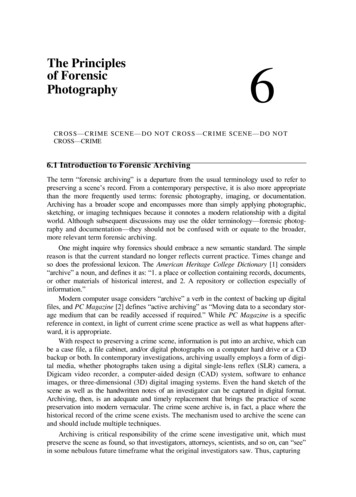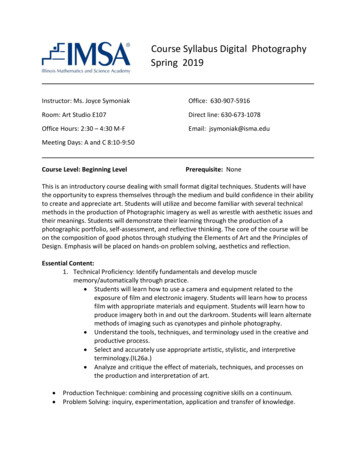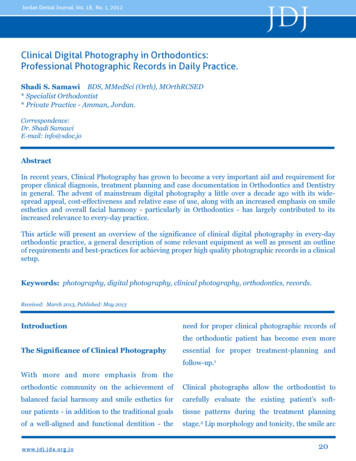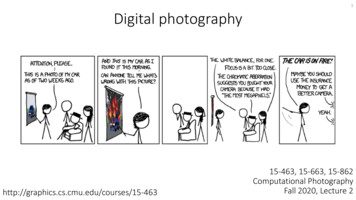
Transcription
1Digital 6315-463, 15-663, 15-862Computational PhotographyFall 2020, Lecture 2
2Course announcements No lecture on Monday (Labor day). Homework 1 will be posted on Friday, will be due September 17th at 23:59. If you are on waitlist, let me know. Office hours for this week only (will finalize starting next week based on survey results):Yannis – Friday 4-6 pm.
3Course announcements Is there anyone not on Piazza?https://piazza.com/class/ksm9uc16vsg4bf Is there anyone not on Canvas?https://canvas.cmu.edu/courses/25153
4Please take the start-of-semester survey and signup for a camera before the weekend!Survey formCamera sign cm7SqPsPyppuIBniFXygAiJDnWBsQCzGKvKY/edit#gid 0Both links available on Piazza.We will use the survey results to finalize all logistics over the weekend.
5Overview of today’s lecture Imaging sensor primer. Color primer. In-camera image processing pipeline. Some general thoughts on the image processing pipeline.Take-home message: The values of pixels in a photograph and the valuesoutput by your camera’s sensor are two very different things.
6Slide creditsA lot of inspiration and quite a few examples for these slides were taken directly from: Kayvon Fatahalian (15-769, Fall 2016). Michael Brown (CVPR 2016 Tutorial on understanding the image processing pipeline). Marc Levoy (Stanford CS 178, Spring 2014).
7The modern photography pipeline
8The modern photography pipelinepost-capture processing(lectures 5-10)optics andoptical controlssensor, analogfront-end, andcolor filter array(lectures 2-3, 11-20) (today, lecture 23)in-camera imageprocessingpipeline(today)
9Imaging sensor primer
10Imaging sensors Very high-level overview of digital imaging sensors. We could spend an entire course covering imaging sensors. Lecture 23 will cover sensors and noise issues in more detail.Canon 6D sensor(20.20 MP, full-frame)
11What does an imaging sensor do?When the camera shutter opens exposure begins array of photon bucketsphotonsclose-up view of photon buckets photon buckets begin to store photons. until the camera shutter closes. Then, theyconvert stored photons to intensity values.
12Shutter speed
13Nobel Prize in PhysicsWho is this?
14Nobel Prize in PhysicsWhat is he known for?
15Photoelectric effectincidentphotonsemittedelectronsAlbert EinsteinEinstein’s Nobel Prize in 1921 “for his services to Theoretical Physics,and especially for his discovery of the law of the photoelectric effect”
16Basic imaging sensor designCanon 6D sensor(20.20 MP, full-frame)
17Basic imaging sensor designmicrolensmicrolensmicrolenscolor filtercolor filtercolor silicon for readout etc. circuitrystores emittedelectronsThe term “photosite” can be used to refer to both theentire pixel and only the photo-sensitive area.Canon 6D sensor(20.20 MP, full-frame)made of silicon, emitselectrons from photons
18Photosite quantum efficiency (QE)How many of the incident photons will the photositeconvert into electrons?QE # electrons# photons Fundamental optical performance metric of imaging sensors. Not the only important optical performance metric! We will see a few more later in the lecture.incidentphotonsemittedelectrons
19Photosite responsenumber of electronsThe photosite response is mostly linearwhat does this slope equal?number of photons
20Photosite responsenumber of electronsThe photosite response is mostly linearwhat happens here?QEnumber of photons
21Photosite responseThe photosite response is mostly linear, but: non-linear near zero (due to noise)We will see how to deal with these issues in alater lecture (high-dynamic-range imaging).under-exposure(non-linearity dueto sensor noise)over-exposure(non-linearity dueto sensor saturation)saturationnumber of electrons non-linear when potential well is saturated(over-exposure)QEnumber of photonsSaturation means that the potentialwell is full before exposure ends.
22Photosite full-well capacityHow many electrons can thephotosite store before saturation? Another important optical performance metric of imaging sensors.
23Pixel pitch and fill factorpixel pitch: size of one side ofsquare pixel (typically 1-20 μm)microlensmicrolensmicrolenscolor filtercolor filtercolor silicon for readout etc. circuitryfill factor: percentage of pixel areataken up by photo-sensitive material
24Microlenses (also called lenslets)pixel pitch: size of one side ofsquare pixel (typically 1-20 μm)microlensmicrolensmicrolenscolor filtercolor filtercolor What is the role of the microlenses?silicon for readout etc. circuitryfill factor: percentage of pixel areataken up by photo-sensitive material
25Microlenses (also called lenslets)microlensmicrolenscolor filtercolor What is the role of the microlenses? Microlenses help photositecollect more light by bending raystowards photosensitive pixel area. Microlenses increase the effectivefill factor.silicon for readout etc. circuitryfill factor: percentage of pixel areataken up by photo-sensitive material
26Microlensesoblique view of microlens arrayclose-up of sensor cross-sectionshifted microlenses for improved fill factor
27Microlenses (also called lenslets)microlensmicrolenscolor filtercolor What is the role of the microlenses? Microlenses help photositecollect more light by bending raystowards photosensitive pixel area. Microlenses increase the effectivefill factor. Microlenses also spatially lowpass filter the image to preventaliasing artifacts.What kind of spatial filter do themicrolenses implement?silicon for readout etc. circuitryfill factor: percentage of pixel areataken up by photo-sensitive material
28Microlenses (also called lenslets)silicon for readout etc. circuitrymicrolensmicrolenscolor filtercolor What is the role of the microlenses? Microlenses help photositecollect more light by bending raystowards photosensitive pixel area. Microlenses increase the effectivefill factor. Microlenses also spatially lowpass filter the image to preventaliasing artifacts by implementinga pixel-sized 2D rect (box) filter. Often an additional optical lowpass filter (OPLF) is placed in frontof the sensor to improve prefilter.fill factor: percentage of pixel areataken up by photo-sensitive material
29Quick aside: optical low-pass filter Sensors often have a separate glass sheet in front of them acting as an optical low-pass filter(OLPF, also known as optical anti-aliasing filter). The OLPF is typically implemented as two birefringent layers, combined with the infrared filter. The two layers split 1 ray into 4 rays, implementing a 4-tap discrete convolution filter kernel.birefringence in a calcite crystalbirefringence ray diagram
30Quick aside: optical low-pass filter Sensors often have a separate glass sheet in front of them acting as an optical low-pass filter(OLPF, also known as optical anti-aliasing filter). The OLPF is typically implemented as two birefringent layers, combined with the infrared filter. The two layers split 1 ray into 4 rays, implementing a 4-tap discrete convolution filter kernel. However, the OLPF means you also lose resolution. Nowadays, due the large number of pixels, OLPF arebecoming unnecessary. Photographers often hack their cameras to remove theOLPF, to avoid the loss of resolution (“hot rodding”). Camera manufacturers offer camera versions with andwithout an OLPF. The OLPF can be problematic also when working withcoherent light (spurious fringes).
31Quick aside: optical low-pass filterExample where OLPF is neededwithout OLPFwith OLPF
32Quick aside: optical low-pass filterExample where OLPF is unnecessarywithout OLPFwith OLPF
33Quick aside: optical low-pass filterIdentical camera model with and without an OLPF (no need for customization).Nikon D800Nikon D800E
34Sensor size “Full frame” corresponds tostandard film size. Digital sensors are often smallerthan film because of cost.
35Two main types of imaging sensorsDo you know them?
36Two main types of imaging sensorsCharged coupled device (CCD):Complementary metal oxide semiconductor (CMOS): per-pixel amplifiers convert charges to voltages row brigade shifts charges row-by-row amplifiers convert charges to voltages row-by-row multiplexer reads voltages row-by-rowCan you think of advantages and disadvantages of each type?
37Two main types of imaging sensorsCharged coupled device (CCD):Complementary metal oxide semiconductor (CMOS): per-pixel amplifiers convert charges to voltages row brigade shifts charges row-by-row amplifiers convert charges to voltages row-by-row multiplexer reads voltages row-by-rowCan you think of advantages and disadvantages of each type?
38Two main types of imaging sensorsCharged coupled device (CCD):Complementary metal oxide semiconductor (CMOS): per-pixel amplifiers convert charges to voltages row brigade shifts charges row-by-row amplifiers convert charges to voltages row-by-row multiplexer reads voltages row-by-row higher sensitivity lower noise faster read-out lower cost
39Artifacts of the two types of sensorssensor bloomsmearing artifactsWhich sensor type can have these artifacts?
40Artifacts of the two types of sensorssensor bloom(CMOS and CCD)smearing artifacts(CCD only)Overflow from saturated pixels mitigated by more electronics to contain charge(at the cost of photosensitive area)
41CCD vs CMOS Modern CMOS sensorshave optical performancecomparable to CCDsensors. Most moderncommercial andindustrial cameras useCMOS sensors.
42CMOS sensor (very) simplified layoutoptically black region(no light gets here)photosite(pixel)row selectionregister Can anyone guess why there arepixels in the optically black region?exposed region(light gets here)active pixel sensor(2D array of pixels)analog front-endrow bufferbits
43Analog front-endanalogvoltageanalogvoltageanalog amplifier (gain): gets voltage in rangeneeded by A/D converter. accommodates ISO settings. accounts for vignetting.analog-to-digitalconverter (ADC): depending on sensor,output has 10-16 bits. most often (?) 12 bits.discretesignaldiscretesignallook-up table (LUT): corrects non-linearities insensor’s response function(within proper exposure). corrects defective pixels.
44VignettingFancy word for: pixels far off the center receive less lightwhite wall under uniform lightmore interesting example of vignetting
45VignettingFour types of vignetting: Mechanical: light rays blocked by hoods, filters, and other objects. Lens: similar, but light rays blocked by lens elements. Natural: due to radiometric laws (“cosine fourth falloff”). Pixel: angle-dependent sensitivity of photosites.non-uniformgain
46What does an imaging sensor do?When the camera shutter opens, the sensor: at every photosite, converts incident photons into electrons stores electrons into the photosite’s potential well while it is not full until camera shutter closes. Then, the analog front-end: reads out photosites’ wells, row-by-row, and converts them to analog signals applies a (possibly non-uniform) gain to these analog signals converts them to digital signals corrects non-linearities and finally returns an image.
47Remember these?helps photositecollect more light(also called lenslet)silicon for readout etc. circuitrymicrolensmicrolenscolor filtercolor stores emittedelectronsWe will see what the color filters are for later in this lecture. Lenslets also filter the imageto avoid resolution artifacts. Lenslets are problematic whenworking with coherent light. Many modern cameras do nothave lenslet arrays.We will discuss these issues inmore detail at a later lecture.made of silicon, emitselectrons from photons
48Color primer
49Color Very high-level of color as it relates to digital photography. We could spend an entire course covering color. We will discuss color in more detail in a later lecture.color is complicated
50Color is an artifact of human perception “Color” is not an objective physical property of light (electromagnetic radiation). Instead, light is characterized by its wavelength.electromagneticspectrumWhat we call “color” is how wesubjectively perceive a very smallrange of these wavelengths.
51Spectral Power Distribution (SPD) Most types of light “contain” more than one wavelengths. We can describe light based on the distribution of power over different wavelengths.We call our sensationof all of thesedistributions “white”.
52Spectral Sensitivity Function (SSF) Any light sensor (digital or not) has different sensitivity to different wavelengths. This is described by the sensor’s spectral sensitivity function When measuring light of a some SPD., the sensor produces a scalar response:light SPD sensor SSFsensorresponseWeighted combination of light’s SPD: light contributes more atwavelengths where the sensor has higher sensitivity.
53Spectral Sensitivity Function of Human Eye The human eye is a collection of light sensors called cone cells. There are three types of cells with different spectral sensitivity functions. Human color perception is three-dimensional (tristimulus color).“short”“medium”“long”cone distributionfor normal vision(64% L, 32% M)
54Color filter arrays (CFA) To measure color with a digital sensor, mimic cone cells of human vision system. “Cones” correspond to pixels that are covered by different color filters, each with itsown spectral sensitivity function.microlensmicrolensmicrolenscolor filtercolor filtercolor ntialwellpotentialwell
55What color filters to use?Two design choices: What spectral sensitivity functionsto use for each color filter? How to spatially arrange (“mosaic”) different color filters?BayermosaicSSF forCanon 50DWhy moregreen pixels?Generally do notmatch human LMS.
56Many different CFAsFinding the “best” CFA mosaic is an active research area.CYGMCanon IXUS, PowershotRGBESony Cyber-shotHow would you go about designing your ownCFA? What criteria would you consider?
57Many different spectral sensitivity functionsEach camera has its more or less unique, and most of the time secret, SSF. Makes it very difficult to correctly reproduce the color of sensor measurements. We will see more about this in the color lecture.Images of the same scene captured using 3 different cameras with identical settings.
58Aside: can you think of other ways to capture color?
59Aside: can you think of other ways to capture color?[Slide credit: Gordon Wetzstein]
60What does an imaging sensor do?When the camera shutter opens, the sensor: at every photosite, converts incident photons into electrons using mosaic’s SSF stores electrons into the photosite’s potential well while it is not full until camera shutter closes. Then, the analog front-end: reads out photosites’ wells, row-by-row, and converts them to analog signals applies a (possibly non-uniform) gain to these analog signals converts them to digital signals corrects non-linearities and finally returns an image.
61After all of this, what does an image look like?lots ofnoisemosaickingartifacts Kind of disappointing. We call this the RAW image.
62The modern photography pipelinepost-capture processing(lectures 5-10)optics andoptical controlssensor, analogfront-end, andcolor filter array(lectures 2-3, 11-20) (today, lecture 23)in-camera imageprocessingpipeline(today)
63The in-camera image processing pipeline
64The (in-camera) image processing pipelineThe sequence of image processing operations applied by the camera’s image signalprocessor (ISP) to convert a RAW image into a “conventional” image.analog reproductionwhitebalancecompressionRAW image(mosaiced,linear, 12-bit)final RGBimage (nonlinear, 8-bit)
65Quick notes on terminology Sometimes the term image signal processor (ISP) is used to refer to the imageprocessing pipeline itself. The process of converting a RAW image to a “conventional” image is often calledrendering (unrelated to the image synthesis procedure of the same name ingraphics). The inverse process, going from a “conventional” image back to RAW is calledderendering.
66The (in-camera) image processing pipelineThe sequence of image processing operations applied by the camera’s image signalprocessor (ISP) to convert a RAW image into a “conventional” image.analog frontenddenoisingCFAdemosaicingsee 18-793see color compressionRAW image(mosaiced,linear, 12-bit)final RGBimage (nonlinear, 8-bit)
67The (in-camera) image processing pipelineThe sequence of image processing operations applied by the camera’s image signalprocessor (ISP) to convert a RAW image into a “conventional” image.analog reproductionwhitebalancecompressionRAW image(mosaiced,linear, 12-bit)final RGBimage (nonlinear, 8-bit)
68White balancingHuman visual system has chromatic adaptation: We can perceive white (and other colors) correctly under different light sources.[Slide credit: Todd Zickler]
69White balancingHuman visual system has chromatic adaptation: We can perceive white (and other colors) correctly under different light sources.[Slide credit: Todd Zickler]
70White balancingHuman visual system has chromatic adaptation: We can perceive white (and other colors) correctly under different light sources.Retinal vsperceived color.[Slide credit: Todd Zickler]
71White balancingHuman visual system has chromatic adaptation: We can perceive white (and other colors) correctly under different light sources. Cameras cannot do that (there is no “camera perception”).White balancing: The process of removing color casts so that colors that we wouldperceive as white are rendered as white in final image.different whitesimage capturedunder fluorescentimage whitebalanced to daylight
72White balancing presetsCameras nowadays come with a large number of presets: You can select which light youare taking images under, and the appropriate white balancing is applied.
73Manual vs automatic white balancingManual white balancing: Select a camera preset based on lighting.Can you think of any other way to do manual white balancing?
74Manual vs automatic white balancingManual white balancing: Select a camera preset based on lighting. Manually select object in photograph that is color-neutral and use it to normalize.How can we do automatic white balancing?
75Manual vs automatic white balancingManual white balancing: Select a camera preset based on lighting. Manually select object in photograph that is color-neutral and use it to normalize.Automatic white balancing: Grey world assumption: force average color of scene to be grey. White world assumption: force brightest object in scene to be white. Sophisticated histogram-based algorithms (what most modern cameras do).
76Automatic white balancingGrey world assumption: Compute per-channel average. Normalize each channel by its average. Normalize by green channel average.white-balancedRGBsensor RGBWhite world assumption: Compute per-channel maximum. Normalize each channel by its maximum. Normalize by green channel maximum.white-balancedRGBsensor RGB
77Automatic white balancing exampleinput imagegrey worldwhite world
78The (in-camera) image processing pipelineThe sequence of image processing operations applied by the camera’s image signalprocessor (ISP) to convert a RAW image into a “conventional” image.analog reproductionwhitebalancecompressionRAW image(mosaiced,linear, 12-bit)final RGBimage (nonlinear, 8-bit)
79CFA demosaicingProduce full RGB image from mosaiced sensor output.Any ideas on how to do this?
80CFA demosaicingProduce full RGB image from mosaiced sensor output.Interpolate from neighbors: Bilinear interpolation (needs 4 neighbors). Bicubic interpolation (needs more neighbors, may overblur). Edge-aware interpolation (more on this later).
81Demosaicing by bilinear interpolationBilinear interpolation: Simply average your 4 neighbors.G2G1 G? G3G? G4Neighborhood changes for different channels:G1 G2 4G3 G4
82The (in-camera) image processing pipelineThe sequence of image processing operations applied by the camera’s image signalprocessor (ISP) to convert a RAW image into a “conventional” image.analog reproductionwhitebalancecompressionRAW image(mosaiced,linear, 12-bit)final RGBimage (nonlinear, 8-bit)
83Noise in imagesCan be very pronounced in low-light images.
84Three types of sensor noise1) (Photon) shot noise: Photon arrival rates are a random process (Poisson distribution). The brighter the scene, the larger the variance of the distribution.2) Dark-shot noise: Emitted electrons due to thermal activity (becomes worse as sensor gets hotter.)3) Read noise: Caused by read-out and AFE electronics (e.g., gain, A/D converter).Bright scene and large pixels: photon shot noise is the main noise source.
85How to denoise?
86How to denoise?Look at the neighborhood around you. Mean filtering (take average):I’ 5 I1I2I3I4I5I6I7I8I9I1 I2 I3 I4 I5 I6 I7 I8 I99 Median filtering (take median):I’ 5 median(I1,I2,I3,I4,I5,I6,I7,I8Large area of research. We will see some more about filtering in a later lecture.,I9)
87The (in-camera) image processing pipelineThe sequence of image processing operations applied by the camera’s image signalprocessor (ISP) to convert a RAW image into a “conventional” image.analog reproductionwhitebalancecompressionRAW image(mosaiced,linear, 12-bit)final RGBimage (nonlinear, 8-bit)
88Perceived vs measured brightness by human eyeWe have already seen that sensor response is linear.Human-eye response (measured brightness) is alsolinear.However, human-eye perception (perceivedbrightness) is non-linear: More sensitive to dark tones. Approximately a Gamma function.
89Gamma encodingAfter this stage, we perform compression, which includes changing from 12 to 8 bits. Apply non-linear curve to use available bits to better encode the information humanvision is more sensitive to.
90Demonstrationoriginal (8-bits, 256 tones)Can you predict what will happen if we linearly encode this tone range with only 5 bits?Can you predict what will happen if we gamma encode this tone range with only 5 bits?
91Demonstrationoriginal (8-bits, 256 tones)linear encoding (5-bits, 32 tones)all of this range getsmapped to just one toneall of these toneslook the sameCan you predict what will happen if we gamma encode this tone range with only 5 bits?
92Demonstrationoriginal (8-bits, 256 tones)linear encoding (5-bits, 32 tones)all of this range getsmapped to just one tonegamma encoding (5-bits, 32 tones)tone encoding becomes a lotmore perceptually uniformall of these toneslook the same
93Tone reproduction pipelinesensor:linear curveISP: concavegamma curvedisplay: convexgamma curve
94Tone reproduction pipelinesensor:linear curveISP: concavegamma curvedisplay: convexgamma curvenet effect: linearcurve
95Tone reproduction pipelinesensor:linear curveISP: concavegamma curvedisplay: convexgamma curvegamma encoding gamma correctionnet effect: linearcurve
96Tone reproduction pipelinehuman visualsystem: concavegamma curveimage a humanwould see atdifferent stages ofthe pipeline
97RAW pipelinegamma encodingis skipped!display still appliesgamma correction!human visualsystem: concavegamma curveRAW image appears verydark! (Unless you areusing a RAW viewer)image a humanwould see atdifferent stages ofthe pipeline
98Historical note CRT displays used to have a response curve that was (almost) exactly equal to the inverseof the human sensitivity curve. Therefore, displays could skip gamma correction anddisplay directly the gamma-encoded images. It is sometimes mentioned that gamma encoding is done to undo the response curve of adisplay. This used to (?) be correct, but it is not true nowadays. Gamma encoding isperformed to ensure a more perceptually-uniform use of the final image’s 8 bits.
99Gamma encoding curvesThe exact gamma encoding curve depends on the camera. Often well approximated as Lγ, for different values of the power γ (“gamma”). A good default is γ 1 / 2.2.before gammaafter gammaWarning: Our values are no longer linear relative to scene radiance!
100The (in-camera) image processing pipelineThe sequence of image processing operations applied by the camera’s image signalprocessor (ISP) to convert a RAW image into a “conventional” image.analog reproductionwhitebalancecompressionRAW image(mosaiced,linear, 12-bit)final RGBimage (nonlinear, 8-bit)
101Some general thoughts on the image processingpipeline
102Do I ever need to use RAW?
103Do I ever need to use RAW?Emphatic yes! Every time you use a physics-based computer vision algorithm, you need linearmeasurements of radiance. Examples: photometric stereo, shape from shading, image-based relighting, illuminationestimation, anything to do with light transport and inverse rendering, etc. Applying the algorithms on non-linear (i.e., not RAW) images will produce completelyinvalid results.
104What if I don’t care about physics-based vision?
105What if I don’t care about physics-based vision?You often still want (rather than need) to use RAW! If you like re-finishing your photos (e.g., on Photoshop), RAW makes your life much easierand your edits much more flexible.
106Are there any downsides to using RAW?
107Are there any downsides to using RAW?Image files are a lot bigger. You burn through multiple memory cards. Your camera will buffer more often when shooting in burst mode. Your computer needs to have sufficient memory to process RAW images.
108Is it even possible to get access to RAW images?
109Is it even possible to get access to RAW images?Quite often yes! Most high-end cameras provide an option to store RAW image files. Certain phone cameras allow, directly or indirectly, access to RAW. Sometimes, it may not be “fully” RAW. The Lightroom app provides images afterdemosaicking but before tone reproduction.
110I forgot to set my camera to RAW, can I still get the RAW file?Nope, tough luck. The image processing pipeline is lossy: After all the steps, information about the originalimage is lost. Sometimes we may be able to reverse a camera’s image processing pipeline if we knowexactly what it does (e.g., by using information from other similar RAW images). The conversion of PNG/JPG back to RAW is known as “derendering” and is an activeresearch area.
111Derendering
112Why did you use italics in the previous slide?What I described today is an “idealized” version of what we think commercial cameras do. Almost all of the steps in both the sensor and image processing pipeline I describedearlier are camera-dependent. Even if we know the basic steps, the implementation details are proprietary informationthat companies actively try to keep secret. I will go back to a few of my slides to show you examples of the above.
113The hypothetical image processing pipelineThe sequence of image processing operations applied by the camera’s image signalprocessor (ISP) to convert a RAW image into a “conventional” image.analog ortransforms?tonereproduction?compression?RAW image(mosaiced,linear, 12-bit)final RGBimage (nonlinear, 8-bit)
114The hypothetical analog front-endanalogvoltageanalogvoltageanalog amplifier (gain): gets voltage in rangeneeded by A/D converter? accommodates ISO settings? accounts for vignetting?analog-to-digitalconverter (ADC): depending on sensor,output has 10-16 bits. most often (?) 12 bits.discretesignaldiscretesignallook-up table (LUT): corrects non-linearities insensor’s response function(within proper exposure)? corrects defective pixels?
115Various curvesAll of these sensitivity curves are different from camera to camera and kept secret.
116Serious inhibition for research Very difficult to get access to ground-truth data at intermediate stages of the pipeline. Very difficult to evaluate effect of new algorithms for specific pipeline stages.
117 but things are getting better
118 but things are getting better
119How do I open a RAW file in Python?You can’t (not easily at least). You need to use one of the following: dcraw – tool for parsing camera-dependent RAW files (specification of file formats arealso kept secret). Adobe DNG – recently(-ish) introduced file format that attempts to standardize RAW filehandling.See Homework 1 for more details.
120Is this the best image processing pipeline?It depends on how you define “best”. This definition is task-dependent. The standard image processing pipeline is designed to create “nice-looking” images. If you want to do physics-based vision, the best image processing pipeline is no pipelineat all (use RAW). What if you want to use images for, e.g., object recognition? Tracking? Robotics SLAM?Face identification? Forensics?De
Very high-level of color as it relates to digital photography. We could spend an entire course covering color. We will discuss color in more detail in a later lecture. color is complicated 40. Color is an a

